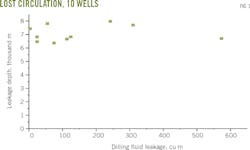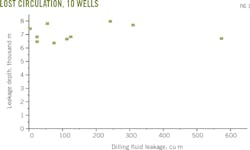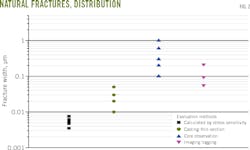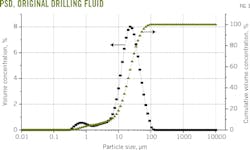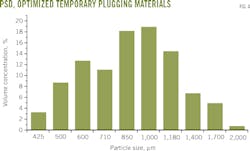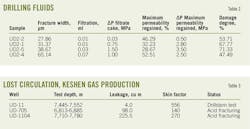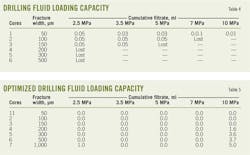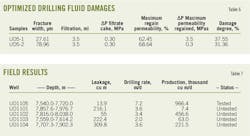Yili Kang
Dujie Zhang
Lijun You
Xiangchen Li
Southwest Petroleum University
Chengdu, China
Jiaxue Li
Chao Huang
PetroChina Tarim Oilfield Co.
Korla, China
PetroChina Tarim Oilfield Co. worked with Southwest Petroleum University researchers to test new drilling fluid technology designed to prevent formation damage for ultradeep fractured tight sandstone gas reservoirs. Researchers tested optimized drilling fluid and temporary plugging materials in Keshen gas field in China's Tarim basin at 7,500 m. Keshen is in the Cretaceous Bashijiqike tight sandstone formation.1
This work built upon previous research into the geological structures, lithology, permeability, porosity, and mineral content of a typical high-pressure, low-permeability, dense reservoir formation in Tarim basin (OGJ, May 19, 2008, p. 45).
Ultradeep fractured gas reservoirs are subject to severe liquid-phase trapping damage, fluids-sensitivity damage, stress-sensitivity damage, and drilling-fluids damage. Original drilling fluids and temporary plugging materials caused severe formation damage, contributing to lost circulation. The original temporary plugging materials were walnut shell, cottonseed hulls, barite, emulsion paraffin, and calcite.
Experimental results showed walnut shell and cottonseed hull to be unsuitable. Barite also proved unsuitable because it decreased filtrate cake's acid solubility.
Researchers added calcite particles containing varying mesh sizes to prevent formation damage caused by the original fluid's small particle distribution. Field tests show the new drilling fluid provided good rheological properties, increased loading capacity, and reduced dynamic damage. Drilling fluid leakage volume also decreased. The test well was drilled twice as fast and its production was higher compared with untested wells.
The modified drilling fluids reduced formation damage. Formulas for optimized temporary plugging materials, required at ultradeep depths, await additional research.
Reservoir damages
Formation thickness is 159 m at 6,500-8,000 m true vertical depth (TVD). The rock is mainly lithic arkose and lithic sandstone. Minerals include quartz (45.1%), feldspar (35.5%), and rock cutting (19.4%).
Pore types are intragranular denudation, intergranular pore, and denudation pore in feldspar fragment. Flaky and curved lamellar throats connect the pores. Reservoir porosity is 2-7%. Permeability is 0.001-0.1 md.
Tectonic activity and tectonic stress created fractures with 0.7-1.47 m linear density. Formation water total salinity is 200,000 mg/l. Most area wells are vertical.
X-ray diffraction showed clay (15.58%), chlorite (18.85%), illite (65.09%), and illite-smectite interstratified minerals (16.06%). The clay tended to swell.
Table 1 shows core test results to evaluate fluids-sensitivity damage.
The reservoir also demonstrated severe salt sensitivity, severe alkali sensitivity, and medium-to-severe water sensitivity. Critical salinity is 15,000 mg/l, and the critical pH value of alkali sensitivity damage is 8.5.
Severe liquid-phase trapping damage exists, but hydrocarbons partially relieve the damage. Mercury injection data showed pore throat radius of 0.09-0.66 μm. Logging data shows initial water saturation of 21.8% on average compared with 40% irreducible water saturation.
Clay minerals divide seepage channels into smaller channels, causing high-capillary force for wetting reservoir rock. Drilling fluids are hard to displace entirely from the reservoir. Standing liquid in the reservoirs reduces permeability.
Experimental results show aqueous damage averaged 74.8% while hydrocarbon-phase trapping damage averaged 53.4%.
Researchers found that oil-based drilling fluids aggravate stress-sensitivity damage. Logging and other data showed insitu fractures' width ranged from 1 nm to a few millimeters.
Multiscale natural fractures provide seepage channels, but the fractures can close under stress.
The stress sensitivity coefficient of fractured samples is 0.69 on average, and damage is medium to severe. The coefficient of formation rock damaged by drilling fluids averaged 0.89, indicating that the original fluid aggravated stress-sensitivity damage.
Oil-based drilling fluids caused solids-invasion damage, fluids-sensitivity damage, and phase-trapping damage. Experiments determined the comprehensive damage of drilling fluids under 3.5-MPa positive-pressure difference at 90° C. for 1 hr.
Researchers tested oil-based drilling fluid from Keshen field. Table 2 shows the cumulative filtrate volume of drilling fluids was less than 1 ml, and the permeability damage degree was less than 60% on average, which cannot meet the 40% requirement of the original design.
Results showed that lost circulation causing serious solids-invasion damage. The original drilling fluids' oil-water ratio of 88-12 effectively reduced fluids-sensitivity damage.
The phase-trapping damage caused by diesel oil is less than that of formation water, indicating original drilling fluids can reduce liquid-phase trapping damage.
Frequent lost circulation was a leading cause of formation damage. Fig. 1 shows lost circulation leakage of 10 completed wells. Leakage volumes varied widely.
A skin region is a zone of altered permeability adjacent to the wellbore.
Skin factors quantify formation damage. Table 3 shows that skin factors of wells UD-702 and UD-1104 were high after acid fracturing, meaning well stimulation did not eliminate all formation damage. Bigger skin factors in Keshen field correlated to greater leak volumes. Table 4 shows that the original drilling fluid has poor loading capacity. Fluids having a 10-MPa positive pressure difference can only seal fracture widths less than 50 μm. Fluids with a 5-MPa positive pressure difference can seal fractures 100 μm wide. Fractures wider than 200 μm cannot be sealed completely. High-density drilling fluids (1.75 g-cc) had a 10-MPa bottom-of-hole positive pressure difference.
Fig. 2 shows natural fracture width ranges of 3-1,000 μm, with most fractures wider than 50 μm.2 Lost circulation is almost unavoidable using original drilling fluid because of its small particle size.
Particle-size distribution (PSD)correlates with loading capacity. Fig. 3 shows the original drilling fluids' PSD. The maximum diameter of 90% of particles (D90) is 46.586 μm. Based on the optimal ratio of particle to the fracture width, the maximum sealable fracture width using these particles is 50 μm. Some temporary plugging materials were inappropriate for oil-based fluid and high temperatures. Walnut shell and cottonseed shell char easily, weakening them and enabling repeated fluid leaks.
Smaller PSD and unsuitable temporary plugging materials caused lost circulation, leading to severe formation damage during drilling.3
Drilling fluids
Researchers changed the PSD based upon earlier research into temporary sealing-loss techniques4 in ultradeep fractured tight sandstone gas reservoirs. The new fluid ensured safer drilling and less lost circulation, cutting expenses.
Researchers evaluated the original temporary plugging materials: walnut shell, cotton seed shell, barite, emulsion paraffin, and calcite with different mesh.5
Calcite particles with different meshes were introduced after evaluation for this reservoir. Three sizes of calcite particle were used: GT-1 (425-1,000 μm), GT-2 (500-1,180 μm), and GT-3 (1,000-2,000 μm). The average acid solubility of calcite is about 99%.
Fig. 4 shows the PSD of temporary plugging materials. Researchers improved the original drilling fluids by adding temporary plugging materials. The desired drilling fluid was attained by increasing GT-1 by 1%, GT-2 by 3%, and GT-3 by 2%.
Making these changes increased D90 to 1,400 μm, bigger than the width of most fractures, meaning the improved drilling fluid is capable of sealing most natural fractures.
Table 5 shows that optimized drilling fluids can seal fractures less than 1,000 μm wide at 10 MPa. Filtrate loss increases slightly in fractures wider than 200 μm, but the cumulative loss is still 5 ml or less.
The improved drilling fluids quickly form filtrate cake to prevent small particles from invading the reservoir. This prevents lost circulation during normal drilling.
Table 6 shows that permeability damage averaged 34.46%. Keshen gas well UD1105 was tested with the improved drilling fluid. The reservoir started at 7,425 m. UD1105's depth was 7,720 m.
Field experiments evaluated the rheological properties, finding the optimized fluids met design requirements.
Table 7 shows well UD1105 had less leakage volume than nearby wells. UD1105 was drilled without incident, testing at 35 MPa before cementing. No circulation was lost during cementing.
Production tests show UD1105 produced 940 thousand cu m/d through a 9-mm nozzle, which was higher production than wells not tested with the improved drilling fluids.
Acknowledgments
The National Natural Science Foundation of China (NO.51474186) and the Sichuan Youth Science and technology innovation research team project (Unconventional Formation Damage Control) supported this research. Yili Kang acknowledges the China Scholarship Council (CSC No. 201708510127) for a joint PhD fellowship and for assistance from his co-supervisor civics engineering and applied mechanics professor Patrick Selvaduraib of McGill University, Montreal, Canada.
References
1. Jia, C., and Pang, X., "Research process and main development direction of deep hydrocarbon geological theories," ACTA Petrolei Sinica, Vol. 36, No. 12, July 13, 2015, pp. 1457-1469.
2. Kang, Y., Xu, C., You, L., Yu, H., and Zhang, D., "Temporary sealing technology to control formation damage induced by drill-in fluid loss in fractured tight gas reservoir," Journal of Natural Gas Science & Engineering, Vol. 20, No. 9, September 2014, pp. 67-73.
3. Dick, M. A., Heinz, T.J., Svoboda, C.F., and Aston, M., "Optimizing the selection of bridging particles for reservoir drilling fluids," SPE International Symposium on Formation Damage Control, Lafayette, La., Feb. 23-24, 2000.
4. Kang, Y., You, L., Xu, X., and Liao, Z., "Practices of formation damage control for deep fractured tight gas reservoir in western Sichuan basin," SPE International Oil & Gas Conference and Exhibition, Beijing, June 8-10, 2010.
5. Zhu, J., Li, L., Li, L., Zhang, Z., Chen, R., Zhang, J., Liu, X., and Li, J., "Application of UDM-2 Drilling Fluid Technology in the Development of Upper-Deep Oil and Gas Resources in Tarim basin," SPE Asia Pacific Unconventional Resources Conference and Exhibition, Brisbane, Nov. 9-11, 2015.
The authors
Yili Kang ([email protected]) is a professor at Southwest Petroleum University School of Oil & Natural Gas Engineering, Chengdu, China. He directs the formation damage control group at the State Key Laboratory of Oil and Gas Reservoirs Geology and Exploration. He holds a BS (1986) in petroleum geology from Daqing Petroleum Institute and an MS (1989) in petroleum geology and PhD (1998) in drilling engineering from Southwest Petroleum University.
Dujie Zhang ([email protected]) is a PhD candidate in Southwest Petroleum University's petroleum engineering department. He holds a BS (2013) in petroleum engineering from Southwest Petroleum University.
Lijun You ([email protected]) is a Southwest Petroleum University professor in the school of oil and natural gas engineering. He holds a BS (2000) in applied geophysics, an MS (2004) in petroleum geology, and a PhD (2006) in well drilling engineering from Southwest Petroleum University.
Xiangchen Li ([email protected]) is a Southwest Petroleum University instructor in the school of oil and natural gas engineering. He holds BS (2005), MS (2008), and PhD (2011) degrees in petroleum engineering from Southwest Petroleum University.
Jiaxue Li ([email protected]) works as a PetroChina Tarim Oilfield Co. senior engineer in the wellbore working fluids research office. He acquired a BS (2004) in petroleum engineering, an MS (2008) in well engineering, and a PhD (2011) in petroleum engineering from Southwest Petroleum University.
Chao Huang ([email protected]) works as a PetroChina Tarim Oilfield Co. assistant engineer in the drilling and completion engineering department of Kuqa oil and gas development division. He obtained a BS (2013) in petroleum engineering from Southwest Petroleum University.
